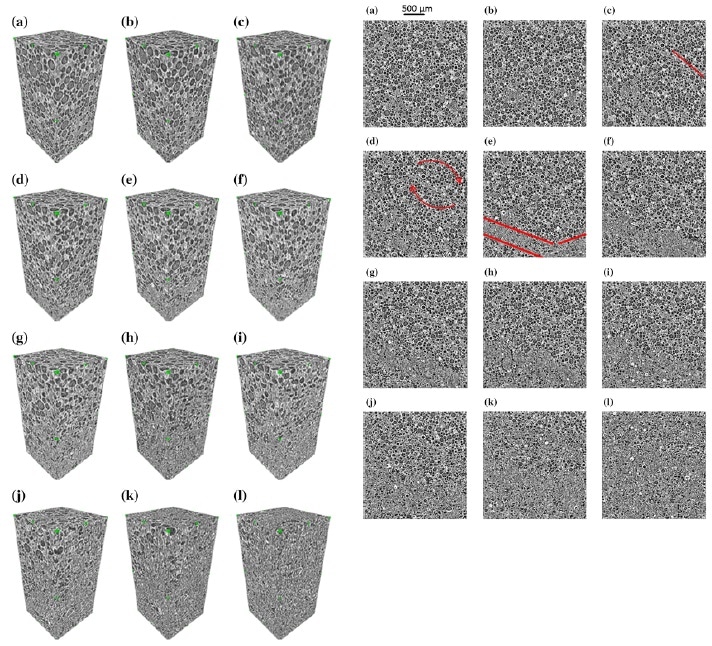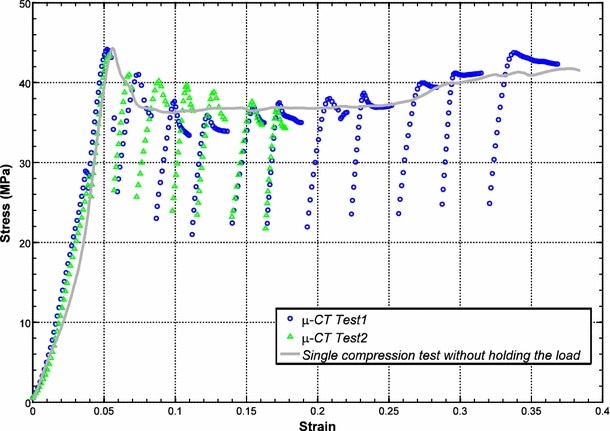Deben, a leading provider of in-situ testing stages together with innovative accessories and components for microscopy, reports on how the University of Aberdeen’s School of Engineering use X-ray microcomputed tomography to observe syntactic foam and its compressive damage mechanisms using the Deben CT5000 μXCT stage.
 Figure 1 (Left) – 3D images of the internal microstructure and failure process and Figure 2 (Right) – XZ images of the same process
Figure 1 (Left) – 3D images of the internal microstructure and failure process and Figure 2 (Right) – XZ images of the same process
In recent work the School of Engineering at the University of Aberdeen carried out in situ experiments to study the failure mechanisms of syntactic foam, using both X-ray microcomputed tomography with uniaxial compression. X-ray microcomputed tomography was used to image the foam whilst it was under compressive strain to obtain 3D images of the internal microstructure and the changes that occurred.
The material studied (polymer matrix syntactic foams) is a low-density composite material. The foam is made by randomly filling hollow particles into a material matrix and is categorised as closed-cell, this is due to fact that the particles are not connected and that each pore is enclosed in the matrix. The properties of syntactic foams are highly influenced by hollow particles. Syntactic foam microstructure is determined by the particle; material, volume fraction and wall thickness. Commonly the hollow particles in polymer matrix syntactic foams are fabricated from glass, ceramic, carbon and fly ash cenospheres. A real life application of syntactic foams is their use as insulation in the offshore oil industry. The foam helps combat the cooler temperatures and higher pressure during the extraction of oil from further out at sea or at greater depths.
The material during these studies was syntactic foam which was provided by Trelleborg (a global engineering group focused on polymer technology). The foam featured hollow glass spheres embedded within an epoxy matrix. Prismatic blocks were machined from a bar measuring 10x10x10mm³. To ensure flat surfaces and to reduce stress concentrations the surfaces of the specimen were ground using abrasive paper.
The X-ray microcomputed tomography was carried out on the ZEISS VersaXRM-410. A microtension/compression testing stage was mounted to the X-ray machines stage. The experimental configuration can be seen in Figure 1. The sample was loaded into the Deben CT5000 inside the 3mm vitreous glassy carbon tube. The dimensions of the sample were carefully determined to ensure that the load needed to reach beyond the elastic limited would not exceed the loadcells capacity. The dimensions also ensured that there was satisfactory X-ray transmission to obtain high-resolution images. The samples were subjected to unconstrained, uniaxial, quasi-static compression test and scanned at various different levels of strain. The sample was placed within the grips of the testing machine and was secured at the top and bottom. The top grip remained stationary and the bottom grip moved up to compress the sample. The strain was held constant during each scan and then increased up before the next scan was taken. The Deben stage control software allowed the applied load and displacement to be controlled.
As seen in figure 3 when under continuous compression the foam progresses through 3 different states of deformation: (1) an initial elastic region where the relationship between stress and strain becomes almost linear, (2) a plateau where only small variations of stress are seen, after stress reaches its maximum value and then a sudden drop in stress and then (3) densification due to an increase in stress.

Figure 3 – Compressive stress-strain curves of foam with and without μ-CT scanning
The experiments were carried out twice under the same parameters to gauge the repeatability and the results obtained indicate that failure initially starts at weak microspheres and spreads from these areas. To read the results and conclusions in more detail please click here to view the full paper.
References
Paper: https://link.springer.com/article/10.1007/s10853-017-1177-4